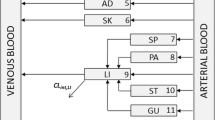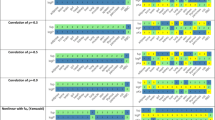Abtract
There are situations in drug development where one may wish to reduce the dimensionality and complexity of whole body physiologically based pharmacokinetic models. A technique for formal reduction of such models, based on global sensitivity analysis, is suggested. Using this approach mean and variance of tissue(s) and/or blood concentrations are preserved in the reduced models. Extended Fourier amplitude sensitivity test (FAST), a global sensitivity technique, takes a sampling approach, acknowledging parameter variability and uncertainty, to calculate the impact of parameters on concentration variance. We used existing literature rules for formal model reduction to identify all possible smaller dimensionally models. To discriminate among those competing mechanistic models extended FAST was used, whereby we treated model structural uncertainty as another factor contributing to the overall uncertainty. A previously developed 14 compartment whole body physiologically based model for diazepam disposition in rat was reduced to three alternative reduced models, with preserved arterial mean and variance concentration profiles.
Similar content being viewed by others
References
M. Müller, A. Pena and H. Derendorf, Issues in pharmacokinetics and pharmacodynamics of anti-infective agents: distribution in tissues. Antimicrob. Agents Chemother. 48 (2004) 1441-1453
W. Elmquist and R.J. Sawchuk, Application of microdialysis in pharmacokinetic studies. Pharm. Res. 14 (1997) 267-288
R.K. Jain, Transport of molecules in the tumour interstitium: a review. Cancer Res. 47 (1987) 3039-3051
C.A. Presant, W. Wolf, V. Maluch, C. Wiseman, P. Kennedy, D. Blayney and R.R. Brechner, Association of intratumour pharmacokinetics of fluorouracil with clinical response. Lancet 343 (1994) 1184-1187
L.T. Baxter, F. Yuan and R.K. Jain, Pharmacokinetic analysis of the perivascular distribution of bifunctional antibodies and haptens: comparison with experimental data. Cancer Res. 52 (1992) 5838-5844
M. Müller, R.M. Mader, B. Steiner, G. Steger, B. Jansen, M. Gnant, T. Helbich, R. Jakesz, H. Eichler and B. Blochl-Daum, 5-Flurouracil kinetics in the interstitial tumour space and clinical response in breast cancer patients. Cancer Res. 57 (1997) 2598-2601
D. Farrar, B. Allen, K. Crump and A. Shipp, Evaluation of uncertainty in input parameters to pharmacokinetic models and the resulting uncertainty in output. Toxicol. Lett. 49 (1989) 371-385
H. Clewell and M. Andersen, Use of physiologically based pharmacokinetic modeling to investigate individual versus population risk. Toxicology 111 (1996) 315-329
A. Gelman, F. Bois and J. Jiang, Physiological pharmacokinetic analysis using population modeling and informative prior distributions. J. Am. Stat. Assoc. 91 (1996) 1400-1412
I. Gueorguieva, I. Nestorov and M. Rowland Fuzzy, simulations of pharmacokinetic models: case study of whole body physiologically based model of diazepam. J Pharmacokin. Pharmacodyn. 31 (2004) 185-211
E. Kuempel, C.-L. Tran, A.J. Bailer, R. Smith, D. Dankovic and L. Stayner, Methodological issues of using observational human data in lung dosimetry models for particulates. Sci. Total. Environ. 274 (2001) 67-77
A.J. Bailer and D.A. Dankovic, An introduction to the use of physiologically based pharmacokinetic models in risk assessment. Stat. Meth. Med. Res. 6 (1997) 341-358
H. Banks and L. Potter, Model predictions and comparisons for three toxicokinetics models for the systemic transport of trichloroethylene. Math. Comput. Model. 35 (2002) 1007-1032
A. Collins, S. Sumner, S. Borghoff and M. Medinsky, A physiological model for tert-amyl ether and tert-amyl alcohol: hypothesis testing of model structures. Toxicol. Sci. 49 (1999) 15-28
I. Nestorov, L. Aarons, P. Arundel and M. Rowland, Lumping of whole-body physiologically based pharmacokinetic models. J. Pharmacokin. Biopharm. 26 (1998) 21-45
A. Saltelli, S. Tarantola and K.P.S. Chan, A quantitative model independent method for global sensitivity analysis of model output. Technometrics 41 (1999) 39-56
J. Crawlfield, Application of first-order (FORM) and second-order (SORM) Reliability Methods: analysis and interpretation of sensitivity measures related to groundwater pressure decreases and resulting ground subsidence. In: A. Saltelli, K. Chan and E.M. Scott (eds.) SensitivityAnalysis. England: J. Wiley & Sons (2000) pp.
M. Crosetto and S. Tarantola, Uncertainty and sensitivity analysis: tools for GIS-based model implementation. Int. J. Geogr. Inf. Sci. 15 (2001) 415-437
C. Planas and R. Depoutot, Sensitivity analysis for signal extraction in economic time series. In: A Saltelli, K. Chan and E.M. Scott (eds.) Sensitivity Analysis. England: J. Wiley & Sons (2000) pp.
D. Draper, A. Saltelli, S. Tarantola, and P. Prado. Scenario and parametric sensitivity and uncertainty analysis in nuclear waste disposal risk assessment: the case of GESAMAC by A. Saltelli, K. Chan, E. M. Scott (eds), J. Wiley & Sons, England, 2000.
A. Saltelli, K. Chan and E.M. Scott, Sensitivity Analysis. England: J. Wiley & Sons (2000).
H.J. Clewell, T. Lee and R.L. Carpenter, Sensitivity of physiologically based pharmacokinetic models to variations in model parameters: methylene chloride. Risk Anal. 14 (1994) 521-531
I. Nestorov, A. Aarons and M. Rowland, Physiologically based pharmacokinetic modelling of a homologous series of barbiturates in the rat: a sensitivity analysis. J. Pharmacokin. Biopharm. 25 (1997) 413-447
M.D. Morris, Factorial sampling plans for preliminary computational experiments. Technometrics 33 (1991) 161-174
S.C. Cotter, A screening design for factorial experiments with interactions. Biometrika 66 (1979) 317-320
R.I. Cukier, C.M. Fortuin, K.E. Shuler, A.G. Petschek and J.H. Schaibly, Study of the sensitivity of coupled reaction systems to uncertainties in rate coefficients. I. Theory. J. Chem. Phys. 59 (1973) 3873-3878
U. Klotz, K.-H. Antonin and P.R. Bieck, Pharmacokinetics and plasma binding of diazepam in man, dog, rabbit, guinea pig and rat. J. Pharmacol. Exp. Ther. 199 (1976) 67-73
Y. Igari, Y. Sugiyama, Y. Sawada, T. Iga and M. Hanano, Prediction of diazepam disposition in the rat and man by a physiologically based pharmacokinetic model. J. Pharmacokin. Biopharm. 11 (1983) 577-593
I. Kuwahira, N Gonzalez, K. Heisler and J. Piper, Regional blood flows in conscious resting rats determined by microsphere distribution. J Appl. Physiol. 74 (1993) 203-210
A. Salteli and S. Tarantola, SimLab 1.1, User Manual. Italy: Joint Research Centre, European Commission (2001).
MATLAB. User’s Guide Version 6.1. The Mathworks, UK.
M. Evans and C. Eklund, A graphical application of sensitivity analysis for gas uptake experiments using chloroform as an example. Toxicol. Method. 11 (2001) 285-297
R.L. Iman and W. Conover, A distribution free approach to inducing rank correlation among input variables. Comm. Statist.-Simula. Computa 11 (1982) 311-334
R.L. Iman and J.C. Helton, A comparison of uncertainty and sensitivity analysis techniques for computer models. Risk Anal. 8 (1988) 71-90
A. Saltelli, T.H. Andres and T. Homma, Sensitivity analysis of model output; An investigation of new techniques. Comput. Stat. Data An. 15 (1993) 211-238
A. Saltelli and J. Marivoet, Nonparametric statistics in sensitivity analysis for model output; A comparison of selected techniques. Reliab. Eng. Syst. Safe. 28 (1990) 229-253
E. Dudewicz and S. Mishra, Modern Mathematical Statistics. New York: John Wiley & Sons (1988).
J.H. Schaibly and K.E. Shuler, Study of the sensitivity of coupled reaction systems to uncertainties in rate coefficients II. Applications. J. Chem. Phys. 59 (1973) 3879-3888
M. Koda, G.L. McRae and J.H. Seinfield, Automatic sensitivity analysis of kinetic mechanisms. Int. J Chem. Kinet. 11 (1979) 427-444
D. Liepmann and G. Stephanopoulos, Development and sensitivity analysis of a closed ecosystem model. Ecol. Model. 30 (1985) 13-47
Y. Lu and S. Mohanty, Sensitivity analysis of a complex, proposed geologic waste disposal system using the Fourier Amplitude Sensitivity Test method. Reliab. Eng. Syst. Safe. 72 (2001) 275-291
G. Box and M. Muller, A note on generation of random normal deviates. Ann. Math. Stat. 28 (1953) 610-611
Author information
Authors and Affiliations
Corresponding author
Rights and permissions
About this article
Cite this article
Gueorguieva, I., Nestorov, I.A. & Rowland, M. Reducing Whole Body Physiologically Based Pharmacokinetic Models Using Global Sensitivity Analysis: Diazepam Case Study. J Pharmacokinet Pharmacodyn 33, 1–27 (2006). https://doi.org/10.1007/s10928-005-0004-8
Received:
Accepted:
Published:
Issue Date:
DOI: https://doi.org/10.1007/s10928-005-0004-8




